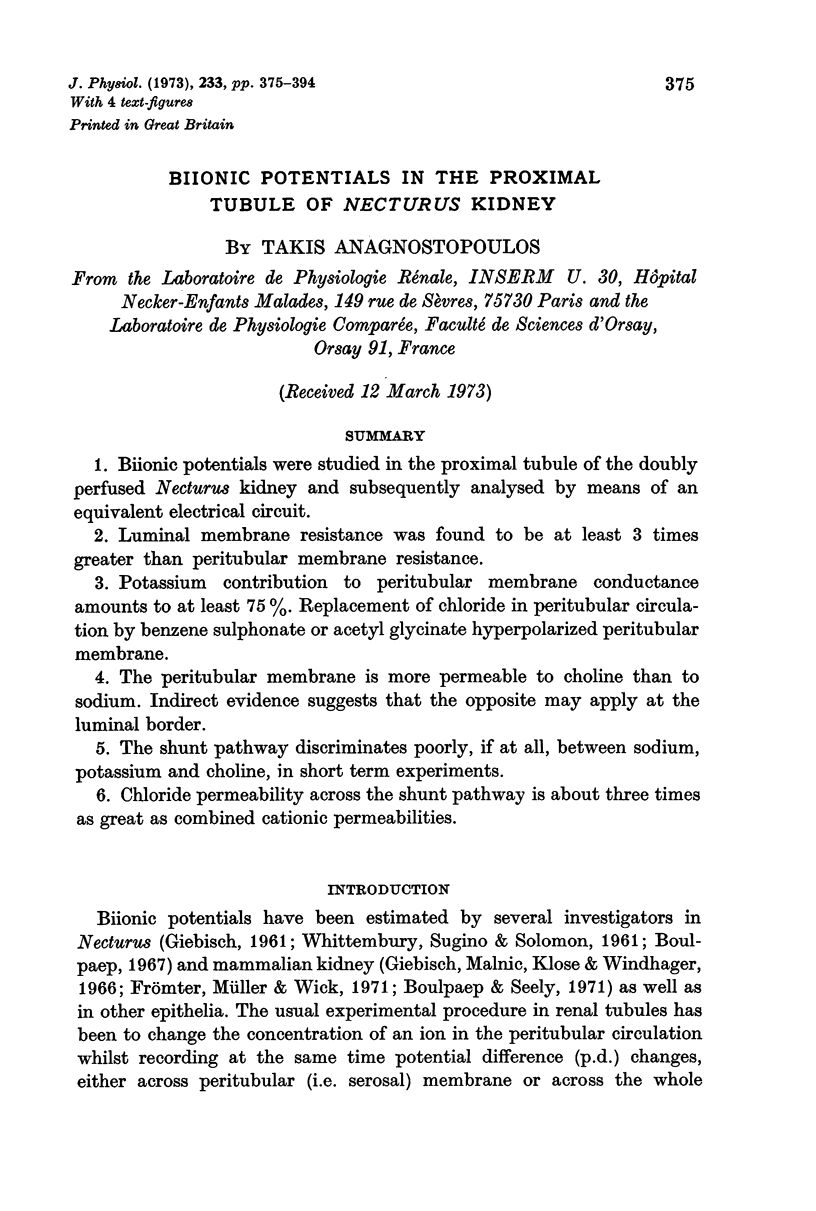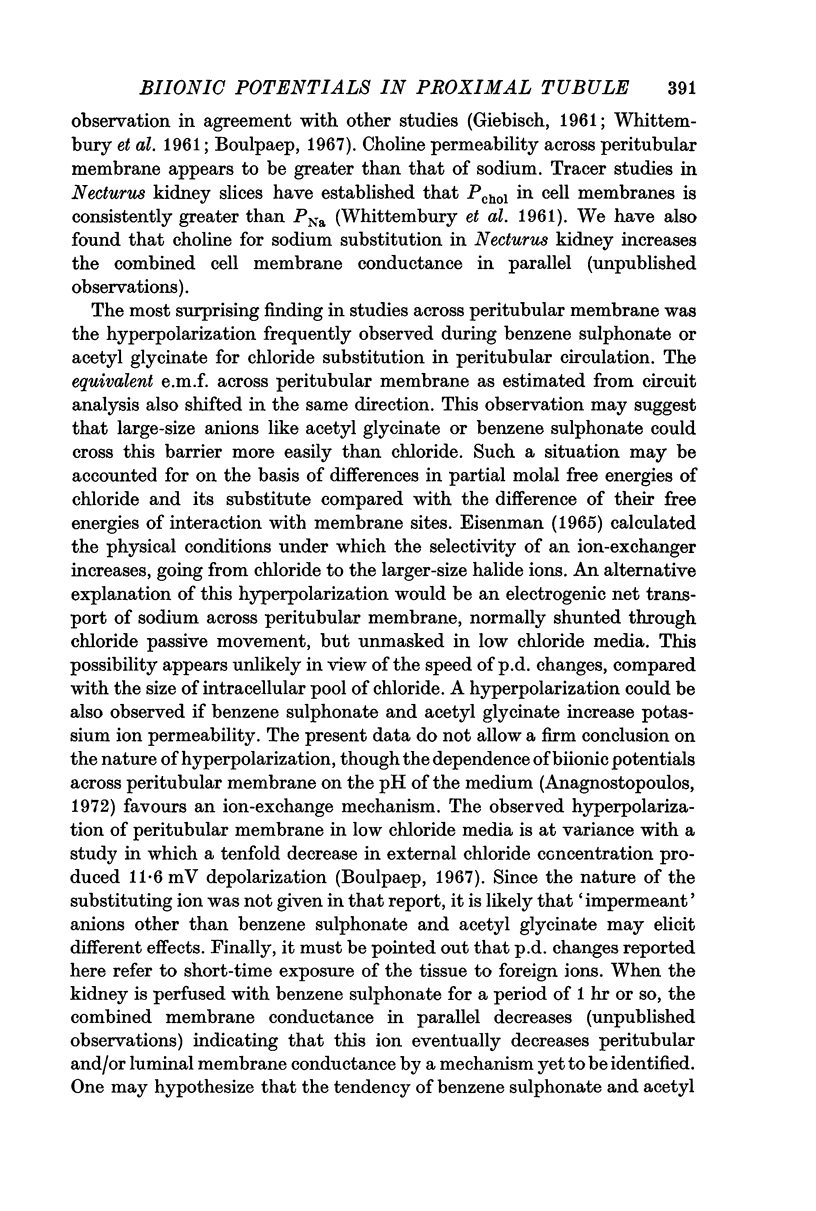Abstract
1. Biionic potentials were studied in the proximal tubule of the doubly perfused Necturus kidney and subsequently analysed by means of an equivalent electrical circuit.
2. Luminal membrane resistance was found to be at least 3 times greater than peritubular membrane resistance.
3. Potassium contribution to peritubular membrane conductance amounts to at least 75%. Replacement of chloride in peritubular circulation by benzene sulphonate or acetyl glycinate hyperpolarized peritubular membrane.
4. The peritubular membrane is more permeable to choline than to sodium. Indirect evidence suggests that the opposite may apply at the luminal border.
5. The shunt pathway discriminates poorly, if at all, between sodium, potassium and choline, in short term experiments.
6. Chloride permeability across the shunt pathway is about three times as great as combined cationic permeabilities.
Full text
PDF



















Selected References
These references are in PubMed. This may not be the complete list of references from this article.
- Bentzel C. J., Anagnostopoulos T., Pandit H. Necturus kidney: its response to effects of isotonic volume expansion. Am J Physiol. 1970 Jan;218(1):205–213. doi: 10.1152/ajplegacy.1970.218.1.205. [DOI] [PubMed] [Google Scholar]
- Boulpaep E. L. Permeability changes of the proximal tubule of Necturus during saline loading. Am J Physiol. 1972 Mar;222(3):517–531. doi: 10.1152/ajplegacy.1972.222.3.517. [DOI] [PubMed] [Google Scholar]
- Boulpaep E. L., Seely J. F. Electrophysiology of proximal and distal tubules in the autoperfused dog kidney. Am J Physiol. 1971 Oct;221(4):1084–1096. doi: 10.1152/ajplegacy.1971.221.4.1084. [DOI] [PubMed] [Google Scholar]
- Frizzell R. A., Schultz S. G. Ionic conductances of extracellular shunt pathway in rabbit ileum. Influence of shunt on transmural sodium transport and electrical potential differences. J Gen Physiol. 1972 Mar;59(3):318–346. doi: 10.1085/jgp.59.3.318. [DOI] [PMC free article] [PubMed] [Google Scholar]
- GIEBISCH G. Measurements of electrical potential differences on single nephrons of the perfused Necturus kidney. J Gen Physiol. 1961 Mar;44:659–678. doi: 10.1085/jgp.44.4.659. [DOI] [PMC free article] [PubMed] [Google Scholar]
- Giebisch G., Malnic G., Klose R. M., Windhager E. E. Effect of ionic substitutions on distal potential differences in rat kidney. Am J Physiol. 1966 Sep;211(3):560–568. doi: 10.1152/ajplegacy.1966.211.3.560. [DOI] [PubMed] [Google Scholar]
- Maruyama T., Hoshi T. The effect of D-glucose on the electrical potential profile across the proximal tubule of newt kidney. Biochim Biophys Acta. 1972 Sep 1;282(1):214–225. doi: 10.1016/0005-2736(72)90327-6. [DOI] [PubMed] [Google Scholar]
- OKEN D. E., SOLOMON A. K. Single proximal tubules of Necturus kidney. VI. Nature of potassium transport. Am J Physiol. 1963 Mar;204:377–380. doi: 10.1152/ajplegacy.1963.204.3.377. [DOI] [PubMed] [Google Scholar]
- OKEN D. E., WHITTEMBURY G., WINDHAGER E. E., SOLOMON A. K. Single proximal tubules of Necturus kidney. V. Unidirectional sodium movement. Am J Physiol. 1963 Mar;204:372–376. doi: 10.1152/ajplegacy.1963.204.3.372. [DOI] [PubMed] [Google Scholar]
- Rose R. C., Schultz S. G. Studies on the electrical potential profile across rabbit ileum. Effects of sugars and amino acids on transmural and transmucosal electrical potential differences. J Gen Physiol. 1971 Jun;57(6):639–663. doi: 10.1085/jgp.57.6.639. [DOI] [PMC free article] [PubMed] [Google Scholar]
- WHITTEMBURY G., SUGINO N., SOLOMON A. K. Ionic permeability and electrical potential differences in Necturus kidney cells. J Gen Physiol. 1961 Mar;44:689–712. doi: 10.1085/jgp.44.4.689. [DOI] [PMC free article] [PubMed] [Google Scholar]


